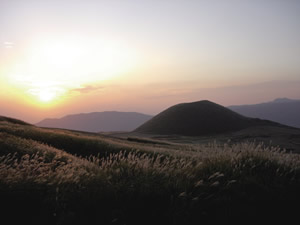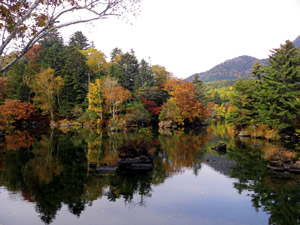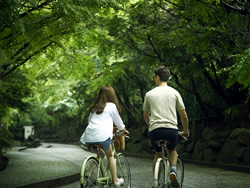Current Topics
"Visit! National Park" project
Make national parks the destinations that tourists all over the world desire to visit
Ministry of the Environment is currently promoting the "Visit! National Park" project, a branding campaign to turn national parks of Japan into world-level national parks based on the "Tourism Vision to Support the Future of Japan," formulated by the Japanese government this past March.
In this project, 8 out of a total of 32 national parks nationwide (as of July 2016 when the selection was made; the current number being 33) were selected as pioneering models. Various measures to enhance attractiveness of the national parks, such as creating a pleasant environment for their use and enhancing park activities, are being carried out in a well-planned and concentrated manner through public-private partnerships to turn them into the world-level national parks that tourists all over the world desire to visit. Through these efforts, the Ministry is aiming to increase the annual number of inbound tourists who visit national parks from 4.3 million in 2015 to 10 million in 2020.
In this and later issues, we would like to introduce the charms of 4 of the 8 national parks selected as pioneering models.
Aso-Kuju National Park
Themes: Scent of Grasslands, Breath of the Volcanoes, Wind Playing across the Majestic Landscape

Aso-Kuju National Park: The Sunset through Komezuka Volcanic Cone of Mt. Aso
The Aso-Kuju National Park is a historic national park born in December 1934.
Located roughly in the center of Kyushu, it is composed of the Aso area in Kumamoto Prefecture and the Kuju area in Oita Prefecture.
The main features of the Park are: Mt. Aso standing on a huge caldera; a volcanic group spreading to the north including Kuju Mountain Range; and magnificent and gentle grasslands surrounding them such as Kuju Plateau and Handa Highland. In spring, this Park's grassland is entirely burned off. The controlled burn has been conducted from over a thousand years ago in order to use the grassland as a silver-grass field or rangeland. In addition, hot springs abound in the north of the Park such as Beppu and Yufuin, making the Park even more attractive.
The Kumamoto Earthquake of April 2016 brought serious damage to the National Park, its reconstruction was part of the reasons why the Park was selected as one of the above-mentioned pioneering models. The photo shows the sunset through the Komezuka volcanic cone of Mt. Aso.
Akan National Park
Themes: A Vast Landscape Comprising Japan's Largest Caldera Landform, Volcanoes, Forests, and Lakes

Akan National Park: Autumn leaves at the lakeside of Akan
Located in the eastern part of Hokkaido, the Akan National Park is one of the longest established national parks in Hokkaido, designated along with Aso-Kuju National Park in December 1934.
The Park can be broadly divided into two areas: the Akan area and the Kawayu area.
In the Akan area, the sights to see include Mt. Me-akan and Mt. O-akan which tower tranquilly over nearby lakes and reservoirs such as Lake Akan and Lake Onneto in a breathtaking landscape. Lake Akan is also famous as the habitat of Marimo (moss balls).
In the Kawayu area, the sights to see are Lake Mashu -- one of the clearest lakes in the world -- as well as Lake Kussharo, which can be viewed from the surrounding mountain passes and peaks, and the colors of the forests, which transform with the seasons.
In January this year, the Japan Tourism Agency chose Kushiro city, where the National Park is located, as one of the Tourism Nation Showcase Cities evaluated to attract inbound tourists to rural areas, which was one of the reasons the Park was selected as one of the pioneering models.
The photo shows autumn leaves at the lakeside of Lake Akan (Takiguchi).
On the Nationwide Campaign "COOL CHOICE"
Wise Choices for the Future
Japan has set a goal to reduce greenhouse gas emissions by 26% in 2030 compared to FY 2013. In order to achieve this goal, Ministry of the Environment in cooperation with relevant ministries and various enterprises, organizations and local governments, is promoting the national campaign called "COOL CHOICE" to encourage people to make "wise choices" in every aspect of life, such as choosing low-carbon "products," "services" and "lifestyle," which serve as global warming countermeasures.
As part of the "COOL CHOICE" campaign, the Ministry is training "Global Warming Prevention Communicators," who convey knowledge on climate change highlighted in the Fifth Assessment Report of the IPCC (Intergovernmental Panel on Climate Change) as well as the latest information on climate change countermeasures, such as the Paris Agreement, the nationwide campaign "COOL CHOICE", and the Plan for Global Warming Countermeasures. The Communicators encourage Japanese people to better understand the current situation of climate change to foster a sense of urgency in each one of them, help them recognize climate change as an immediate issue, and feel motivated to take voluntary actions. Through various activities including events for parents and children, large-scale seminars, and outreach lectures at elementary and junior high schools, the Communicators urge people to change their lifestyle to the one which is suited to low-carbon society by letting each one of them understand the issue of climate change and recognize it as an immediate issue.
COOL CHOICEs in various familiar scenes of life


LED lighting, which is gaining attention for its energy-saving performance and long life, is an eco-friendly lighting choice.

Public transportation such as trains and buses is a transportation mode with fewer carbon emissions.

Biking and walking are the ultimate green transportation with zero carbon emissions.

Summer vegetables can cool down your body. Keep the room temperature at 28℃ by cooling down the heat inside the body.

Choosing an eco-friendly vehicle would make a big difference in a low carbon society.



